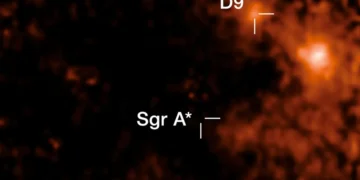Astronomy never ceases to amaze us. The recent discovery of D9, a binary star system orbiting the supermassive black hole at the center of the Milky Way, has added yet another layer of intrigue to our understanding of the cosmos.
Binary Stars in a Harsh Neighborhood
Binary star systems are not uncommon; in fact, more than half of all stars in the universe have one or more companions. However, finding such systems near a supermassive black hole is unprecedented.
Black holes are notorious for their immense gravity, which exerts powerful tidal forces capable of disrupting even tightly bound stellar pairs. Yet, D9 stands as proof that binary stars can endure this harsh gravitational environment, at least for a limited time.
Astronomers had previously assumed that binary systems near supermassive black holes would be unstable, with one star likely ejected while the other spiraled toward the black hole.
A Technological Triumph: How D9 Was Discovered
Discovering a binary star system near Sagittarius A* is no small feat. The team, led by Florian Peißker from the University of Cologne, used the European Southern Observatory’s Very Large Telescope (VLT) in Chile to make this groundbreaking observation.
Over 15 years, they monitored subtle changes in the object’s light emissions, revealing a regular 372-day pattern caused by the Doppler Effect. This periodic fluctuation was the smoking gun that confirmed D9 as a binary star system.
The two stars in D9 are young, estimated to be about 2.7 million years old. One star is approximately 2.8 times the mass of the Sun, while its companion is significantly smaller, at about 0.7 solar masses. Locked in a tight orbital dance, they come as close as 0.095 light-years to Sagittarius A*.
Why This Discovery Is So Significant
1. Challenging Assumptions About Black Hole Destruction
Conventional wisdom held that supermassive black holes like Sgr A* are destructive forces, tearing apart nearby star systems. D9’s survival tells a different story. While the system is expected to merge into a single star within a million years—a blink of an eye on cosmic timescales—it demonstrates that black holes are not as uniformly destructive as previously believed.
2. Shedding Light on Mysterious G Objects
Astronomers have long been puzzled by so-called G objects near Sgr A*. These enigmatic clumps of gas and dust behave like stars but exhibit unusual characteristics. The discovery of D9 provides a new perspective: these G objects might be binary systems in the process of merging or remnants of past mergers.
3. Raising the Possibility of Planets Near Black Holes
Perhaps the most tantalizing implication of D9’s discovery is the potential for planets. Young stars like those in D9 are often accompanied by planetary systems. If such planets exist, they would be subject to extreme gravitational and radiation conditions, offering a unique laboratory for studying planetary formation and survival in hostile environments.
The Future of Binary Systems Near Black Holes
While D9 is a fleeting phenomenon in cosmic terms, its discovery opens the door to finding more such systems. Advanced telescopes like the James Webb Space Telescope (JWST) and the upcoming Extremely Large Telescope (ELT) are poised to search for similar binary systems and even planets near supermassive black holes. The predicted merger of D9 into a single star will provide valuable data on the life cycles of binary systems in extreme environments.
Conclusion
The discovery of D9 near Sagittarius A* is a landmark in our quest to understand the cosmos. It challenges established theories, raises exciting new questions, and exemplifies the ingenuity of modern astronomy. As we continue to explore the heart of our galaxy and beyond, D9 serves as a reminder that the universe is full of mysteries waiting to be uncovered.
Reference:
A binary system in the S cluster close to the supermassive black hole Sagittarius A*



















